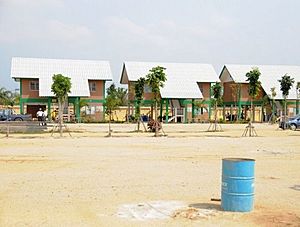Child protection facts for kids
Child protection is the safeguarding of children from violence, exploitation, abuse, and neglect. It involves identifying signs of potential harm, responding to allegations or suspicions of abuse, providing support and services to protect children, and holding those who have harmed them accountable.
The primary goal of child protection is to ensure that all children are safe and free from harm. Child protection also works to prevent future harm by creating policies and systems that identify and respond to risks before they lead to harm.
It is the responsibility of individuals, organizations and governments to ensure that children are protected from harm and their rights are respected. This includes providing a safe environment for children to grow and develop and ensuring they have access to education, healthcare and other basic needs.
Contents
Encountered problems
Child labour
Child labour is the practice of having children engage in economic activity, on a part- or full-time basis. The practice deprives children of their childhood, and is harmful to their physical and mental development. It is considered to be a form of exploitation and is illegal in many countries.
Due to economic reasons, especially in poor countries, children are forced to work in order to survive. Child labour often happens in difficult conditions, which are dangerous and impair the education of the future citizens and increase vulnerability to adults. It is hard to know exactly the age and number of children who work. At least 152 million children under 5 years of age worked in 2016, but the figure is underestimated because domestic labour is not counted.
Parental responsibility
Parental responsibility is the legal obligation of a parent to provide for their child's physical, emotional, and financial needs. This includes providing food, shelter, clothing, education, medical care, and emotional support. It also includes protecting the child from harm and ensuring their safety. Child abuse and neglect is failure by a person with parental or any other protective responsibility to exercise the powers for the intended purpose, which is the benefit of the child.
Actions typically include services aimed at supporting at-risk families so they can remain intact to safeguard and promote the welfare of the child, investigation of alleged child abuse and, if necessary, assuming parental responsibility by foster care and adoption services.
Child maltreatment
Child maltreatment refers to anything done to an infant because he or she cannot defend himself. The maltreatments can be beatings, speaking harshly to the child, denying the child food, stopping the child from going to school, and many others. This can be physical, social, psychological, emotional, and so on.
Many caregivers maltreat children, some because they were adopted and their own biological children came after adoption. Some are abused or maltreated because they were maids; some as a result of colour color or out of anger.
Other
A 2014 European Commission survey on child protection systems listed the following among the categories of children needing help:
- Child victims of bullying or cyberbullying
- Children affected by custody disputes, including parental child abduction
- Children belonging to minority ethnic groups, e.g. Roma
- Children left behind (by parents who move to another EU country for work)
- Children in a situation of migration
- Children in judicial proceedings
- Children in or at risk of poverty
- Children in police custody or detention
- Children of parents in prison or custody
- Children with disabilities
- Children without parental care/in alternative care
- Children who are not in compulsory education or training or working children below the legal age for work
- Missing children (e.g. runaways, abducted children, unaccompanied children going missing)
- Unaccompanied children in a situation of migration
Child protection

Most countries have introduced laws to protect, prevent children and young persons from certain threats or harms.
Throughout much of the 19th century there was minimal protection for the safely of children. The rights of parents to raise their children as they wished as well as the ability of adult authority figures to establish obedience in their charges through corporal punishment was given priority.
Attitudes were shifting by the 1880s. The Children's Charter which came into law in 1889 gave the state the ability to intervene in the parent-child relationship in order to prevent mistreatment for the first time.
Today, Article 19 of the UN Convention on the Rights of the Child provides for the protection of children in and out of the home. UNICEF defines a ‘child protection system’ as the set of laws, policies, regulations and services needed across all social sectors – especially social welfare, education, health, security and justice – to support prevention and response to protection-related risks. These systems are part of social protection, and extend beyond it. At the level of prevention, their aim includes supporting and strengthening families to reduce social exclusion, and to lower the risk of separation, violence and exploitation. Responsibilities are often spread across government agencies, with services delivered by local authorities, non-state providers, and community groups.
Prominent child protection organizations
- Free the Children
- Friends-International
- Mannerheim League for Child Welfare
- Odisha State Child Protection Society
- Save the Children
- War Child
- World Vision
- UNICEF
- TARA Homes for Children [fr]
See also

